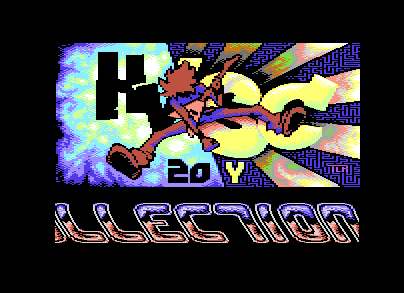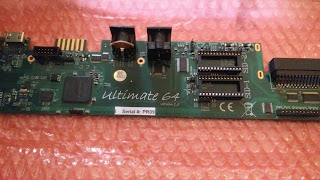Interview with Wilfred Bos on 17/12/2017
Besides Gideon Zweijtzer and Jan Derogee I also interviewed Wilfred Bos on that rainy Saturday December 17th 2017 in Maarssen(NL) during the bi-monthly gathering of the Commodore and Amiga enthusiasts .
To me he forms the Dutch Dynamic Trio with Gideon and Jan considering their ingenuity and creativity in the Commodore scene.
Who is Wilfred Bos I hear you say? Well shame on you, every musing loving C64 user should know it! :)
Wilfred his besides being a caring husband and father also a valued member of the Commodore scene and also an active member of the High Voltage SID Collection team.
Wilfred gave us the very first SID player for the C64 in 1996. The Ultimate SID player in the Ultimate C64 & The ACID player on PC that can handle all kind of Sids via software or hardware.
His piece de resistance is his upcoming ACID C64 network Player in combination with the 1541 Ultimate II & the Ultimate C64. :D
Read the interview and find out more about him.
How did you end on the C64?
As a little kid I played a lot outside and I did some pranks in the neighborhood which was not always appreciated by my neighbors. My parents wanted me more at home and they asked me if I would like to have a video recorder or computer. I told them that I would like to have a computer and especially a Commodore 64 since I already had seen one. That was in 1984 and in January 1985 my dad bought a C64 for himself and he let me use it as well. I was 12 years old and the result was that since then I didn’t play a lot outside anymore☺
At first, I just played games on the C64 and when I was 14 I started to program in assembly since I wanted to do things that was not possible using BASIC. I started to make demos with some friends and we called ourselves Channel Four.
In 1989 I got an Amiga for my birthday and I did some programming on it in assembly. In 1992 I switched to the PC and I made some small demos in assembly. In 1995 I started to make a SID player in assembler without emulating the SID. At that time, I was studying computer science and I met Peter Wendrich (known from the Chameleon cartridge). I told him that I was busy with writing a SID player and then we had the idea to make use of a real SID chip. We sat together and Peter made a test board with a SID chip on it connected to the parallel port and then we added some code to my SID player to control the SID chip on that board and by our own surprise we could play the tune from Commando on it in just an afternoon.We then made two prototype boards and I continued programming on the player but since we had no time to manufacture the board, the project was put on hold.
At first, I just played games on the C64 and when I was 14 I started to program in assembly since I wanted to do things that was not possible using BASIC. I started to make demos with some friends and we called ourselves Channel Four.
In 1989 I got an Amiga for my birthday and I did some programming on it in assembly. In 1992 I switched to the PC and I made some small demos in assembly. In 1995 I started to make a SID player in assembler without emulating the SID. At that time, I was studying computer science and I met Peter Wendrich (known from the Chameleon cartridge). I told him that I was busy with writing a SID player and then we had the idea to make use of a real SID chip. We sat together and Peter made a test board with a SID chip on it connected to the parallel port and then we added some code to my SID player to control the SID chip on that board and by our own surprise we could play the tune from Commando on it in just an afternoon.We then made two prototype boards and I continued programming on the player but since we had no time to manufacture the board, the project was put on hold.
In 2003 my girlfriend got pregnant, which gave me more time in the evenings to do some programming and I picked up my old project again which I transformed in a Windows application. I made support for the HardSID ISA card and called my program ACID64. I released ACID64 in June 2003.
Where does your passion for music come from?
What tools do you use when you’re programming for the C64?
When I started programming on the C64, I made use of the monitor of the Power Cartridge and saved all my code on tape. Later I got a disk drive and in 1988 I started to write code in Turbo Assembler.
For my C64 related projects I use several programming languages, like Delphi and Java. When I am programming for the C64, I make use of 64tass assembler on the PC.
What music tools do you use on the C64 & PC?
I don’t make use of music tools on the C64 since I don’t make music for the C64.
Since I’m a member of the High Voltage SID Collection crew, I make use of tools to rip music from C64 programs. I made several tools for identifying SID tunes, for calculating song lengths, for cleaning SID tunes and packing them, for identifying the play routine of a SID, etc.
You were a member of the Channel Four Group. Where does this name come from?
Well in the Netherlands we had 3 TV channels in the 80s in the town I grew up, namely NED1, NED2 and NED3. For us the C64 was connected to Channel Four!!
Channel Four demos can be found here: http://csdb.dk/group/?id=1566
When did you make the first Ultimate Player for the 1541 Ultimate?
I made the first Ultimate Player version in 2009. Currently I’m busy with an update of the player. The player will get support for sub tune selection via the keyboard and a clock will be displayed with a time bar. Also, it will get song length support.
How long did it take to have this first Ultimate Player version?
At that time, I could program the player during the day and it took me about a month to finish it.
Do you want to share something with our group?
I make programs because of my own needs and because I like programming. I like when people enjoy my programs which motivates me even more to do more programming.
Thanks for your helpful answers Wilfred!!
The video below gives you a little taste of how crowdy and noisy it is during our meetings in Maarssen.
Funny note for the quick observer, during filming my cellphone went of. I didn't edit it out of the footage because I wanted to you to hear that i'm a SID addict.😄
Can you guess which SID it is then please leave a note below? I wonder how many people will recognise it.😊
In 2016 he made an intro for this music colection: http://csdb.dk/release/?id=149405
Link to Wilfred's websit: Acid64.com.
All Wilfred's demos can be found on CDSB: http://csdb.dk/scener/?id=6746










































